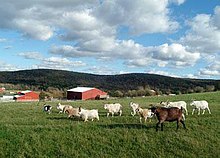
An animal sanctuary is a facility where animals are brought to live and to be protected for the rest of their lives.[1] Pattrice Jones, co-founder of VINE Sanctuary defines an animal sanctuary as "a safe-enough place or relationship within the continuing hazards that menace everybody".[2] In addition, sanctuaries are an experimental staging ground for transformative human–animal relations.[3] There are five types of animal sanctuaries reflective of the species-belonging of the residents: 1) companion animal sanctuaries; 2) wildlife sanctuaries; 3) exotic animal sanctuaries; 4) farmed animal sanctuaries; and 5) cetacean sanctuaries.
Unlike animal shelters, sanctuaries do not seek to place animals with individuals or groups, instead maintaining each animal until their natural death (either from disease or from other animals in the sanctuary). However, they can offer rehoming services, which can include veterinarians' help.[4] In some cases, an establishment may have characteristics of both a sanctuary and a shelter; for instance, some animals may be in residence temporarily until a good home is found and others may be permanent residents. The mission of sanctuaries is generally to be safe havens, where the animals receive the best care that the sanctuaries can provide. Animals are not bought, sold, or traded, nor are they used for animal testing. Additionally, no parts of nor secretions from the animals are commodified, such as eggs, wool, or milk. The resident animals are given the opportunity to behave as natural as possible in a protective environment.[1]
- ^ a b Tom Regan (2006). Jaulas Vacías. El Desafío de los Derechos de los Animales (in Spanish). Barcelona: Fundación Altarriba. p. 111. ISBN 978-84-611-0672-1.
- ^ "About Us". VINE Sanctuary. 2010-11-27. Retrieved 2020-04-15.
- ^ Pachitat, Timothy. "Sanctuary". In Gruen, Lori (ed.). Critical Terms for Animal Studies. The University of Chicago Press. pp. 335–355.
- ^ Successful rehoming requires a coordinated and cooperative approach, and it is important that research establishments, rehoming organisations, animal welfare organisations and veterinarians work together to achieve an appropriate outcome for animals at the end of their use in research.https://www.animalethics.org.au/__data/assets/pdf_file/0005/1275251/Research-Animal-Rehoming-Guidelines.pdf